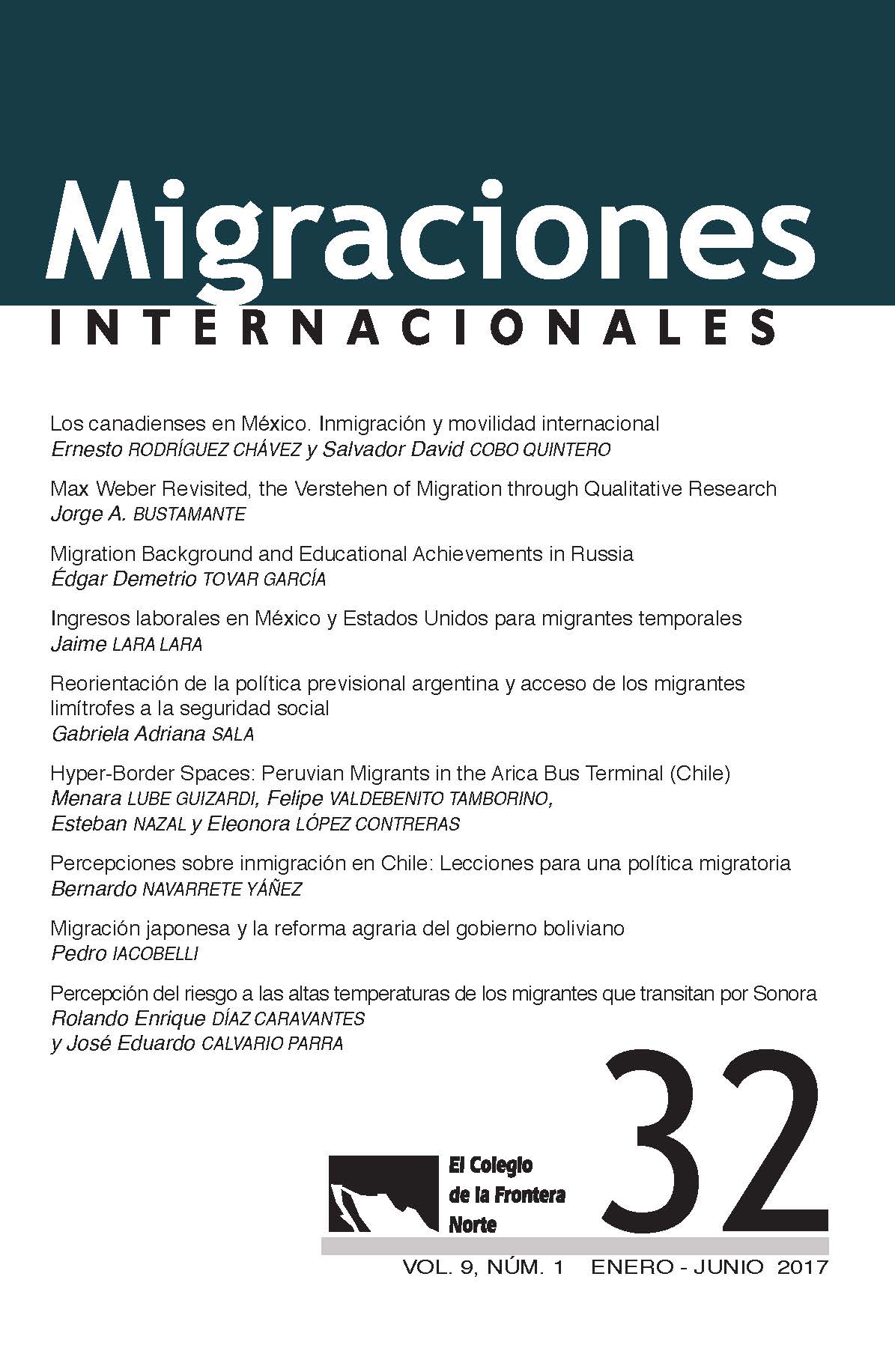Percepción del riesgo a las altas temperaturas de los migrantes que transitan por Sonora
DOI:
https://doi.org/10.17428/rmi.v9i32.895Palabras clave:
riesgo, altas temperaturas, percepción, migrantes, fronteraResumen
De 2001 a 2013 murieron en la frontera sur de Arizona 2 184 personas, de las cuales alrededor de 75 por ciento perecieron por hipertermia, golpe de calor o deshidratación. Aunque resulta claro que las condiciones ambientales de la región Sonora-Arizona son de alto riesgo los migrantes siguen cruzando por ella, de allí que surge el objetivo de este estudio: examinar la percepción de los migrantes sobre el riesgo a las altas temperaturas. Con base en 27 entrevistas realizadas en albergues de Agua Prieta y Ciudad Obregón, Sonora, se encontró que sólo una tercera parte de los entrevistados consideraban las altas temperaturas un problema para su salud, por lo que se concluye que esta minimización del riesgo se debe a un exceso y saturación de peligros relacionados con la violencia hacia sus personas en su recorrido por México.
Descargas
Referencias
ALARCÓN, Rafael, 2011, “us Immigration Policy and the Mobility of Mexicans (1882-2005)”, Migraciones Internacionales, Tijuana, El Colef, vol. vi, núm. 1, pp. 185-218.
ALONSO MENESES, Guillermo, 2013, El desierto de los sueños rotos: Detenciones y muertes de migrantes en la frontera México-Estados Unidos 1993-2013, Tijuana, El Colef.
ÁLVAREZ HERNÁNDEZ , Gerardo, 2008, “Limitaciones metodológicas de la epidemiología moderna y una alternativa para superarlas: La epidemiología sociocultural”, Región y Sociedad, Hermosillo, El Colegio de Sonora, vol. xx, pp. 51-75.
BECK, Ulrich, 1992, Risk Society, London, Sage Publications.
BECK, Ulrich, 1998, “La política de la sociedad de riesgo”, Estudios Demográficos y Urbanos, México, El Colegio de México, vol. XIII, núm. 3, pp. 501-515.
CALVARIO PARRA, José Eduardo y Rolando Enrique DÍAZ CARAVANTES, 2017, “Al calor de la masculinidad. Clima, migración y normativas de género en la costa de Hermosillo, Sonora”, Región y Sociedad, El Colson, núm. especial 5, pp. 115–46.
CARDONA, Omar Darío, 1993, “Evaluación de la amenaza, la vulnerabilidad y el riesgo”, en Andrew Maskrey, edit., Los desastres no son naturales, Panamá, Red de Estudios Sociales en Prevención de Desastres en América Latina, pp. 45-65.
CASILLA R., Rodolfo, 2008, “Las rutas de los centroamericanos por México, un ejercicio de caracterización, actores principales y complejidades”, Migración y Desarrollo, México, Red Internacional de Migración y Desarrollo, vol. x, pp. 157-174.
COMISIÓN INTERAMERICANA DE DERECHOS HUMANOS (CIDH), 2013, “Derechos Humanos de los migrantes y otras personas en el contexto de la movilidad humana en México”, Washington, cidh.
CORNELIUS, Wayne A, 2001, “Death at the Border: Efficacy and Unintended Consequences of US Immigration Control Policy”, Population and Development Review, Estados Unidos, Wiley Blackwell, vol. XXVII, núm. 4, pp. 661-685.
DÍAZ CARAVANTES, Rolando E.; Ana Lucía CASTRO LUQUE y Patricia ARANDA GALLEGOS, 2014, “Mortalidad por calor natural excesivo en el noroeste de México: Condicionantes sociales asociados a esta causa de muerte”, Frontera Norte, Tijuana, El Colef, vol. XXVI, núm. 52, pp. 155-177.
DOUGLAS, Mary, 1996, La aceptabilidad del riesgo según las Ciencias Sociales, Barcelona, Paidós.
DOUGLAS, Mary y Aaron WILDAVSKY, 1983, Risk and Culture, Berkeley, University of California Press.
EDWARDS, Ward, 1954, “The Theory of Decision Making”, Psychological Bulletin, American Psychological Association, Washington, vol. li, núm. 4, pp. 380-417.
HUMANE BORDERS [publicación digital], 2014, “Map of Migrant Mortality”, Tucscon, Humane Borders, en , consultado el 27 de octubre de 2014.
JOFFE, Hélène, 2003, “Risk: From Perception to Social Representation”, British Journal of Social Psychology, Wiley, Estados Unidos, vol. XLII, pp. 55-73.
KASPERSON, Roger E.; Ortwin RENN, Paul SLOVIC, Halina S. BROWN, Jacque EMEL, Robert GOBLE, Jeanne X. KASPERSON y Samuel RATICK, 1988, “The Social Amplification of Risk; A Conceptual Framework.”, Risk Analysis, Wiley, Estados Unidos, vol. VIII, núm. 2, pp. 177-187.
KOFF, Harlan, 2014, “The EU Migration-Security Nexus: The Reinforcement and Externalization of Borders from the Center”, Policy Papers, París, Organization for Economic Co-operation and Development (OECD).
LAVELL, Allan, 2000, “Desastres y desarrollo: hacia un entendimiento de las formas de construcción social de un desastre: El caso del huracán Mitch en Centroamérica”, en Nora Garita y Jorge Nowalski, edits., Del desastre al desarrollo sostenible: El caso de Mitch en Centroamerica, San José de Costa Rica, Banco Interamericano de Desarrollo y Centro Internacional para el Desarrollo Humano Sostenible.
LUHMANN, Niklas, 2006, Sociología del riesgo, México, Universidad Iberoamericana.
MAGAÑA, Víctor y Cecilia CONDE, 2000, “Climate and Freshwater Resources in Northern Mexico: Sonora, a Case Study”, Environmental Monitoring and Assessment, Alemania, Springer, vol. LXI, núm. 1, pp. 167-185.
MASKREY, Andrew, 1993, Los desastres no son naturales, Panamá, Red de Estudios Sociales en Prevención de Desastres en América Latina.
MASSEY, Douglas S.; Jorge DURAND y Nolan J. MALONE, 2009, “Ensamblaje de la maquinaria: una historia de la migración México- Estados Unidos”, en Detrás de la trama. Políticas migratorias entre México y Estados Unidos, México, Miguel Ángel Porrúa/ Universidad Autónoma de Zacatecas, pp. 31-60.
MENÉNDEZ, Eduardo L., 1998, “Estilos de vida, riesgos y construcción social”, Estudios sociológicos, México, El Colegio de México, vol. XVI, núm. 46, pp. 37-67.
NEVINS, Joseph, 2002, Operation Gatekeeper: the rise of the “illegal alien” and the making of the US -Mexico boundary, Nueva York, Routledge.
ORGANIZACIÓN INTERNACIONAL PARA LAS MIGRACIONES (OIM), 2013, “Informe sobre las migraciones en el mundo 2013”, México, OIM.
RUBIO-GOLDSMITH, Raquel, M. Melissa McCormick, Daniel MARTINEZ e Inez Magdalena DUARTE, 2006, The ‘Funnel Effect’ & Recovered Bodies of Unauthorized Migrants Processed by the Pima County Office of the Medical Examiner, 1990-2005, Tucson, Binational Migration Institute.
RUIZ, Olivia, 2001, “Riesgo, migración y espacios fronterizos: Una reflexión”, Estudios Demográficos y Urbanos, México, El Colegio de México, núm. 47, pp. 257-284.
RUIZ, Olivia y red de las casas del migrante-scalabrini, 2001, “Los riesgos de cruzar. La migración centroamericana en la frontera México-Guatemala”, Frontera Norte, Tijuana, El Colef, vol. XIII, núm 25, pp. 7-41.
SLACK, Jeremy; Daniel MARTINEZ, Scott WHITEFORD y Emily PHEIFFER, 2013, In the shadow of the wall: family separation, immigraton enforcement and security. Preliminary data from the migrant border crossing study, Berkeley, The Center for Latin American Studies-University of Arizona, en <http://works.bepress.com/scott_whiteford/2>.
SLOVIC, Paul, 1987, “Perception of Risk”, Science, Washington, American Association for the Advance of Science, vol. xxiii, núm. 4799, pp. 280-285.
SLOVIC, Paul, 2000, Risk Perception, Londres, Earthscan.
SLOVIC, Paul; Melissa L. finucane, Ellen peters y Donald G. MacGregor, 2004, “Risk as Analysis and Risk as Feelings: Some Thoughts about Affect, Reason, Risk, and Rationality”, Risk Analysis, Estados Unidos, Wiley, vol. XXIV, núm. 2, pp. 311-322.
SERVICIO METEREOLOGICO NACIONAL, 2012, “Pronóstico por ciudades”, México, gob.mx, en , consultado el 12 de agosto de 2014.
STRAHLER, Arthur, 1973, Introduction to Physical Geography, Estados Unidos, Wiley.
VALDEZ GARDEA, Gloria Ciria, 2007, Diagnóstico para la atención institucional a la infancia indígena migrante en Sonora, Hermosillo, Comisión Nacional para el Desarrollo de los Pueblos Indígenas.
WILCHES-CHAUX, Gustavo, 1993, “La Vulnerabilidad Global”, en Andrew Maskrey, edit., Panamá, Red de Estudios Sociales en Prevención de Desastres en América Latina, pp. 11-44.
Publicado
Número
Sección
Licencia
Las/los autoras/es que publiquen en esta revista aceptan las siguientes condiciones:
- Las/los autoras/es conservan los derechos de autor y ceden a la revista Migraciones Internacionales (RMI) el derecho de la primera publicación, mediante el registro de los textos con la licencia de Creative Commons Atribución-No comercial-Sin derivar 4.0 internacional (CC BY-NC-ND 4.0), que permite a terceros utilizar lo publicado siempre que mencionen la autoría del trabajo y a la primera publicación en esta revista.
- Autorizan que su artículo y todos los materiales incluidos en él sean reproducidos, publicados, traducidos, comunicados y transmitidos públicamente en cualquier forma o medio; así como efectuar su distribución al público en el número de ejemplares que se requieran y su comunicación pública, en cada una de sus modalidades, incluida su puesta a disposición del público a través de medios electrónicos o de cualquier otra tecnología, para fines exclusivamente científicos, culturales, de difusión y sin fines comerciales.
- Los autores/as pueden realizar otros acuerdos contractuales independientes y adicionales para la distribución no exclusiva de la versión del artículo publicado en esta revista (por ejemplo: incluirlo en un repositorio institucional, página web personal; o bien publicarlo en un libro) siempre que sea sin fines comerciales e indiquen claramente que el trabajo se publicó por primera vez en Migraciones Internacionales (RMI), [agregando la ficha bibliográfica correspondiente: Autor/es. (año). Título del artículo. Migraciones Internacionales, volumen (número), pp. doi: xxxx ].
Para ello, las/los autoras/es deben remitir el formato de carta-cesión de la propiedad de los derechos de la primera publicación debidamente llenado y firmado. Este documento debe cargarse en formato PDF en archivos complementarios dentro de la plataforma OJS.
Este obra está bajo una licencia de Creative Commons Atribución-No comercial-Sin derivar 4.0 internacional (CC BY-NC-ND 4.0)..













